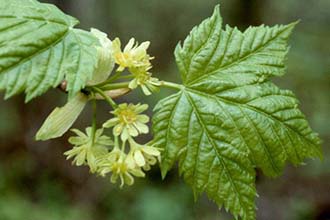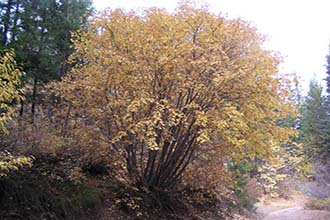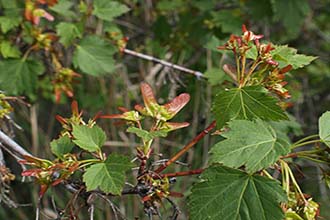Taxonomy: Kingdom - Plantae (plants). Subkingdom - Tracheobionta (vascular plants). Superdivision - Spermatophyta (seed plants). Division - Magnoliophyta (flowering plants). Class - Magnoliopsida (dicotyledons). Subclass - Rosidae. Order - Sapindales. Family - Sapindaceae (maple). Genus - Acer L. Species - Acer glabrum Torr.
Ecology: Rocky Mountain maple occurs in old-growth and second-growth forests. It is found in early seral stages, growing within the first 10 years following fire through mature and climax stages. Rocky Mountain maple is a major component or dominant in seral shrub-dominant vegetation, which develops rapidly following disturbance in the northern Rockies. Seral shrubfields result from recurring disturbance including fire and downslope movement of snow, ice, water, and rocks. Rocky Mountain maple is found with a variety of tree species throughout its range, including white fir (Abies concolor), subalpine fir (Abies lasiocarpa), alder (Alnus spp.), birch (Betula spp.), common juniper (Juniperus communis), Rocky Mountain juniper (Juniperus scopulorum), western juniper (Juniperus occidentalis), Engelmann spruce (Picea engelmannii), lodgepole pine (Pinus contorta), limber pine (Pinus flexilis), ponderosa pine (Pinus ponderosa), cottonwood (Populus spp.), quaking aspen (Populus tremuloides), Douglas-fir (Pseudotsuga menziesii), oak (Quercus spp.), and willow (Salix spp.).
In the WFDP: Rocky Mountain maple is very rare in the WFDP, with only one stem above 1 cm at DBH that has been recorded.



